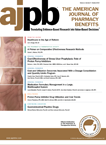Publication
Article
AJPB® Translating Evidence-Based Research Into Value-Based Decisions®
Medication Formulary Management in a Large, Multihospital System
Author(s):
Clarian Health, an 11-hospital health system, developed and managed a multihospital formulary through focused planning and collaboration.
Successfully maintaining a formulary that represents cost-effective, evidence-based medicine requires a collaborative effort among hospital administrators, physicians, and pharmacists.1-3 This challenge becomes more complicated when multiple hospitals within a health system unify medication management efforts. Various health systems have reported varying levels of systemwide coordination and collaboration among hospitals within the same system.4-6 However, there is sparse literature evaluating the benefits, challenges, and outcomes of aligning multiple hospital formularies in a health system, as well as the resulting purpose and function of institution-specific pharmacy and therapeutics (P&T) committees.
Ideally, uniform medication management within a multihospital health system will (1) allow for continuity in practice by healthcare practitioners who provide services at more than 1 hospital within a system, and (2) promote continuity of care for patients who are transferred between hospitals. Clarian Health, a multihospital health system in Indiana, has made efforts to coordinate drug-expenditure budgets and maintain consistency in formulary management by establishing a multihospital formulary committee (MHFC) charged with developing and maintaining a global, systemwide formulary.
Overview of Clarian Health and the Clarian Drug Information Center
Clarian Health was originally formed in 1997 through the merger of 3 hospitals: Methodist Hospital, Indiana University Medical Center, and Riley Hospital for Children, all of which are located in downtown Indianapolis. At the inception of Clarian Health, Methodist, Indiana University, and Riley hospitals dissolved their individual P&T committees, established a single P&T committee (the Clarian Downtown P&T Committee), and began maintaining a single formulary. The integration of the P&T committees of these 3 hospitals has been described previously.2 In 2007-2009, Clarian Health acquired 8 additional hospitals throughout the state of Indiana, including critical access, community, and teaching institutions (Table). Outpatient clinics associated with the acquired hospitals were incorporated into the health system as well. All hospitals were converted to the same wholesale supplier and order system. Current combined annual drug spending is now $130 million.
The Clarian Drug Information Center (DIC), based in the Methodist Hospital, provides support to both the Clarian Downtown P&T Committee and the MHFC through the provision of medication and cost information to assist the committee with decision making. Services provided to the committee include, but are not limited to, preparation of drug monographs, class reviews, and medication-use evaluations; responding to formulary inquiries; providing direction during drug shortages; coordination of P&T committee meetings and presentation of agenda items; assistance addressing issues regarding implementation of new products; and communicating formulary changes and related information to pharmacists and medical staff. The DIC also provides guidance on safety concerns associated with medication use.
Establishment of the Multihospital Formulary Committee
Creation of the MHFC at Clarian Health was facilitated by close collaboration among the DIC staff, physician representatives, nursing representatives, and pharmacy directors from each institution. Approximately 6 months of planning were required to create the committee, write necessary policies regarding function of the committee, determine the formulary review process, and begin formal meetings. At this time, the scope of the MHFC is limited to formulary decisions, establishment of criteria-based restrictions for use of certain drugs, and related information. Individual P&T committees outside downtown Indianapolis were not dissolved with the creation of the MHFC; rather, each hospital continued to function with a separate P&T committee to address specific policy initiatives at their individual facility.
To ensure representation from clinicians across the system, MHFC members include at least 1 physician, 1 nurse, and 1 pharmacist from each individual hospital. The manager of drug use policy, quality improvement, and regulatory compliance for Methodist, Indiana University, and Riley hospitals was chosen as secretary of the MHFC. The chairperson of the committee is a physician chosen by members of the committee. Subcommittees referred to as drug specialty panels (DSPs) also were established. These subcommittees, composed of practitioners specializing in specific disciplines, were developed for the ultimate purpose of making recommendations to the MHFC when it reviews formulary requests involving specific therapeutic areas. Therapeutic areas represented by these global DSPs include adult medicine, pediatric medicine, hematology/oncology, nutrition support, and adult cardiology. Efforts are being made to establish additional DSPs for other specialty areas. These subcommittees meet as needed, depending on the MHFC agenda items.
Creation and Maintenance of a Multihospital Formulary
Once the MHFC was established and began to meet, the process of consolidating individual hospital formularies into 1 formulary took place over 6 months. Initially, identical products listed on all individual formularies were identified and included in the multihospital formulary. Decisions on differences were negotiated during subcommittee meetings involving representatives from each facility. For all formulary decisions, each hospital has 1 vote regardless of size. Official MHFC meetings occur every other month. The medical executive committee and chief medical officer for each facility are notified of all recommendations voted on by the committee, who in turn enforce these decisions at their respective institutions. Because of differing patient populations and services offered, not all products are used by every institution and each hospital has the option of choosing not to stock an item that would be infrequently used at their institution.
A formulary request can be initiated by a pharmacist or a physician. In addition, DIC staff can proactively initiate the process. Requests from pharmacists or physicians must be submitted electronically via a standardized form available from the institution’s intranet. In response, the DIC staff determines whether a full review of the requested product is necessary. If deemed necessary, a single drug monograph or a class review is prepared by the DIC staff. If a full review is not required, the request is fast-tracked and sent straight to the MHFC for a recommendation.
New formulary requests also prompt a notification to informatics personnel to prepare for a potential addition to the Cerner order entry system, Pyxis Medstation automated medication dispensing cabinets, and Alaris Guardrails Suite smart pump software. Once created, monographs and class reviews are sent to the DSPs representing the primary therapeutic areas treated by the drug, as well as to individual P&T committees for review and recommendation. All facilities are expected to review the product before the MHFC meeting.
If a drug is approved for addition to formulary, the MHFC will determine whether use of the product needs to be standardized. Product implementation, ordering details, and a distribution start date are planned during a post-committee meeting. This planning currently is accomplished via a teleconference call. Pharmacy informatics personnel then add the product to the Cerner order entry system, Pyxis Medstation automated medication dispensing cabinets, and Alaris Guardrails Suite smart pump software. In recognition of safety concerns, all efforts are made to synchronize these primary drug databases in terms of drug names, strengths, concentrations, and descriptions. Formulary changes are communicated to each campus, facilitated by the DIC staff. Pharmacy purchasing personnel and the DIC maintain a formulary list made viewable electronically via Lexi-Comp Formulink and a Microsoft Excel document available on the pharmacy shared network drive. The Figure depicts the steps of the review process.
Obstacles to Establishing and Managing the Multihospital Formulary
Establishing an effective formulary committee and managing a global drug formulary require considerable amounts of time, resources, and labor. The DIC staff undertook the responsibility of facilitating the development of an 11-hospital formulary system while continuing to support the Clarian Downtown P&T Committee at Methodist, Indiana University, and Riley hospitals. Supporting the MHFC has been a major challenge in terms of increased workload for the DIC, which has seen a 50% increase in the number of P&T committee meetings to prepare for and facilitate. There also has been a substantial increase in the volume of drug information requests due to the overall growth of the hospital system. Staff and other personnel working in the DIC at the time the MHFC was established included the manager of drug use policy, quality improvement, and regulatory compliance; 1 faculty member from Butler University College of Pharmacy and Health Sciences; 1 faculty member from the Purdue University School of Pharmaceutical Sciences; various pharmacy residents and pharmacy students completing drug information experiential rotations in the DIC; 3 medication safety pharmacists; and an administrative assistant. Subsequently, 2 new drug information pharmacist positions were added to the DIC.
Coordination of efforts to educate all clinicians at each hospital regarding formulary changes is challenging. The DIC gives a regularly scheduled presentation to pharmacists at the Indianapolis hospitals, outlining the latest decisions made by the MHFC as well as dates when the changes will be implemented. Efforts are being made to record the presentation or establish a podcast for viewing at the other institutions. The slide set presented is made available electronically to all institutions. The DIC also develops newsletters for pharmacists and a separate newsletter for physicians, informing them of recent drug policy and formulary changes, which is made available electronically to all institutions.
Future Directions
Initially, the primary focus of the MHFC has been coordination and management of the unified formulary process at Clarian. However, as that process becomes more established, responsibilities of the MHFC likely will expand. The MHFC may begin to help the health system address differences in needs between inpatient drug use and outpatient clinic drug use, and to develop global drug use policies and global medication safety initiatives as well as other performance improvement efforts.
In addition, drug shortages and use of nonformulary products currently are not addressed in a standardized manner across Clarian. Each institution establishes individual restrictions on use of drugs in short supply and use of drugs not on the formulary. Discussions are under way to determine how the MHFC can provide global oversight to uniformly manage shortages and establish criteria for use of nonformulary drugs.
One of the primary goals in developing a global formulary at Clarian Health was to standardize medication use and control drug costs. Reorganization of the formulary management process was considered necessary to successfully manage this responsibility. Clarian Health established a multihospital formulary after 12 months of focused planning and the efforts of hospital administration and physician representatives working closely with the DIC staff to facilitate the process. Because development of the MHFC is in the preliminary stage, it is too early to determine the outcomes resulting from this new process. Impact on drug utilization, drug expenditure, and patient safety will be monitored and evaluated in the future.

Newsletter
Stay informed on drug updates, treatment guidelines, and pharmacy practice trends—subscribe to Pharmacy Times for weekly clinical insights.






